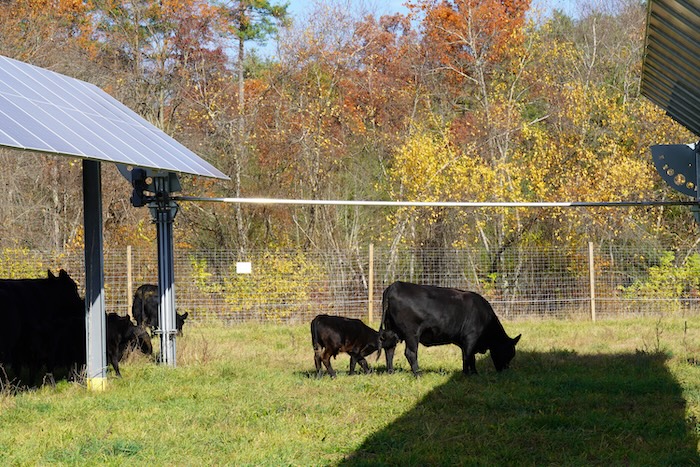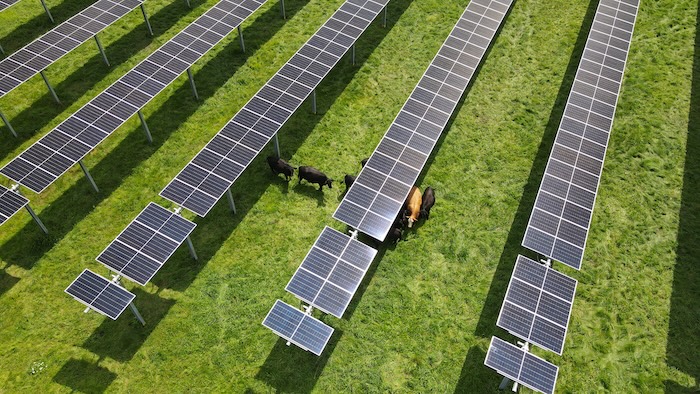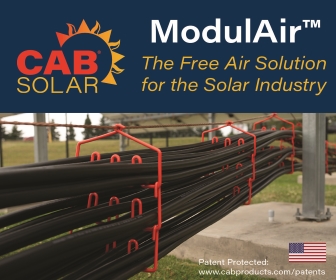Scaling Agrivoltaics with Intention
A heifer swats a fly with her tail while chewing her cud and lazily observing the visitors in hard hats on the other side of the electric netting. A calf trots up to her mother, nudging the udder with her head and starting to nurse, while another cow is scratching an itch using one of thousands of metal I-beams that were recently added to their pasture. Some of the calves will stay on this farm for several years as breeding stock. Others will be sent to slaughter in a year or two and enter the local food system. Whether the cattle are out here grazing or in the barn, the 3,504 solar panels that have been installed above their heads will continue tracking the sun, producing roughly 3300 MWh of electricity every year.

Depending how you feel about solar energy or animal consumption, the above scene could seem idyllic or dystopian. You may have doubts about the ability of the solar array to withstand the presence of cattle, or of the pasture to produce with the addition of shade. Regardless, what is happening at Burgundy Brook Farm is proof of the possibility of agrivoltaics. The combination of solar energy and agricultural production presents a true win-win situation, an opportunity to decrease the emissions intensity of our electric grid while increasing the resilience and economic viability of family-owned farms.
The 2 MW array at Burgundy Brook Farm in Palmer, Massachusetts, is one of a growing number of agrivoltaics installations across the country. Though not every solar site will be suitable for agricultural production, the percentage that are agrivoltaic could – and should – be increased far beyond the 5 percent of installations currently estimated by American Farmland Trust.
When assessing a site for agrivoltaic potential, there are four key factors to examine:
- Agronomic potential: The success or failure of agricultural production on a solar site is strongly influenced by the history and underlying productivity of the land. Is the site forested or cleared farmland or desert? Has it been farmed continuously for decades? Annual precipitation defines what is possible without irrigation. Soil tests set a baseline for soil health and determine what amendments may be necessary.
- Landowner goals: If a developer leases land for solar, the specific goals of the landowner must be considered. Some farming landowners may be ready to retire and may not have descendants interested in operating the family farm. The landowner may want their tenant farmer to maintain access to the land. Ideally, agrivoltaics sites will be designed for maximum flexibility in the farming operation over the decades-long life of the solar facility. As consumer demand and climatic conditions shift, farmers need to be able to adapt. However, site or financial considerations may prevent a given array from being designed with maximum row spacing or panel height. Perhaps the landowner wants to graze sheep and has no need for increased height. Collaboration between the developer, landowner, and farmer results in arrays that work for everyone.
- Local agroeconomy: The operations plan for an agrivoltaics site must be economically viable within the local context. The availability of farm equipment that fits in the array, nearby processing capacity, and the local market for the specific crop or livestock must be taken into consideration. Farmers hold this knowledge; their partnership is crucial.
- Solar market: For any solar project, the energy revenue strategy will have a large impact on the agrivoltaic possibilities. Some states such as Massachusetts (where Burgundy Brook Farm is located) have incentivized agrivoltaics. Arrays that adhere to state standards and submit annual reports on agricultural production receive increased compensation for the energy produced. This revenue stream incentivizes adaptation on the part of the developer and increases willingness to innovate. Arrays under development in Massachusetts will feature production of apples, conifers, diversified vegetables, poultry, blueberries, cattle, and hay. In unincentivized markets, a more common form of agrivoltaics is sheep grazing. This practice has spread across 129,000 acres in the United States, according to the American Solar Grazing Association 2024 Census, and is revolutionizing the sheep industry.

At Burgundy Brook Farm in Palmer, comprehensive assessment of these factors and collaboration with the landowner led to construction of an array that features hay production and cattle grazing. While the cattle are grazing, temporary electric fencing is used to separate paddocks and isolate the equipment pad. Engineered to withstand the region’s infamous Nor’easters, the use of foundations as scratching posts will not cause harm. On a hot day, the cattle will follow the line of shade produced by the single-axis trackers. Revenue from the solar lease has allowed the farm family to expand their farm and will increase the farm’s long-term viability. Producing both solar energy and food for humans, this project proves the potential and possibility of agrivoltaics.
Gabrielle Hayes is a Manager of Sustainable Solar Development at BlueWave, where she supports teams working on site acquisition, development, construction and operations to maximize the benefits of their work for farmers, farming communities, and the land. She has several years of experience working as an urban farmer and food justice educator, and holds a Master of Public Administration focused on Sustainable Development from Columbia University’s School of International and Public Affairs.
BlueWave | bluewave.energy
Author: Gabrielle Hayes
Volume: 2025 September/October










.png?r=7957)

